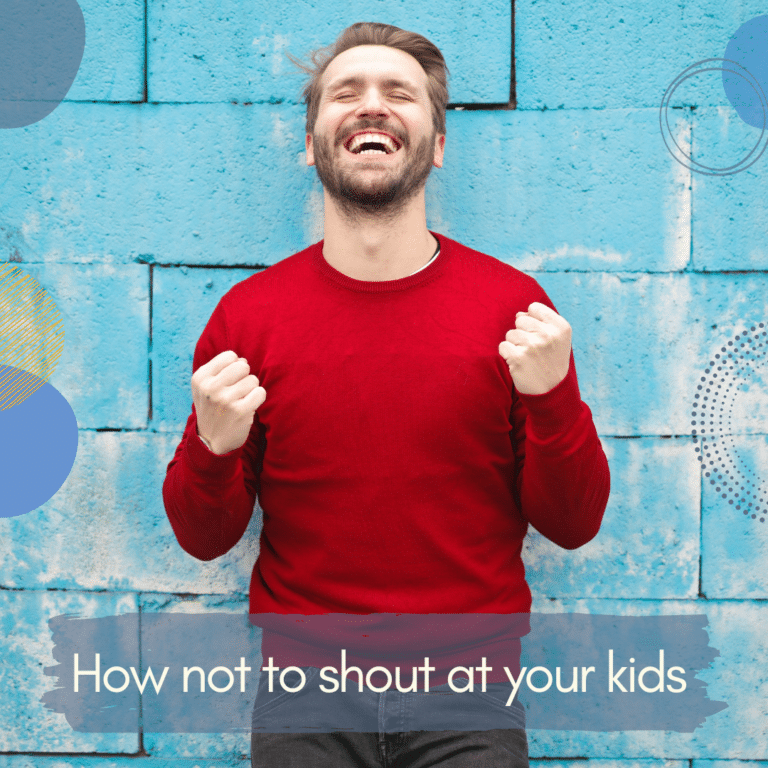How not to shout at your kids
As parents, we all know that shouting at our kids isn’t a great idea. None of us embarked on parenting with ‘Shouty Mum/Dad’ as our ideal destination. But somewhere along the way, we get sucked into it. Especially when nothing seems to work and the kids just won’t do as they are told. Most of us shout because we don’t know how not to shout.
The problem is that shouting simply models to children that raising your voice is the best way to get what you want. Usually, it starts off as a last resort – we ask calmly, we ask calmly, we ask calmly again. And when we still get ignored after all that asking, we end up shouting.
However, shouting can quickly become a habitual dynamic. Our children learn that Mum/Dad doesn’t really mean it until they start shouting. And we learn that we might as well just go straight to shouting because that’s the only thing that ever works!
Whether you’re stuck in the shouty parenting trap or just keen to avoid it, here are some simple tips on how not to shout.
Notice your anger triggers
If you are shouting out of anger or frustration, it’s important to learn to recognise those rising emotions before they take over and hijack your brain. It might be that there are circumstantial triggers – for example, you often get angry at certain parts of the day (e.g. when you are struggling to get the kids out of the house in the morning). Or you might notice internal signals (like your own stress levels). If you can learn to recognise these high risk moments, you can come up with a specific plan for how not to shout at those times. Or, you can remind yourself to walk away, take a moment, and calm down before you lose your cool.
Manage your thoughts to manage your feelings
On the face of it, it might seem like it is your child who is making you shout. But when we inspect a little closer, and we are truly honest with ourselves, we can often trace our shouting back to our own thoughts and beliefs.
Pay close attention to the words you are using inside your head in those shouty parenting moments. If you find yourself annoyed about what your child “should” or “shouldn’t” be doing, you may have fallen into the Should/Shouldn’t thinking trap. For example, if your child is playing with their toys instead of getting dressed, you might be saying to yourself that they “should know better” or that you “shouldn’t have to tell them every day.”
Notice what goes on in your body when you have these thoughts. Is your heart racing? Your head pounding? Do you feel a sense of pressure to do something? What actions might these thoughts and sensations lead to? A shouting match?
What alternative thoughts might you have in these circumstances? Maybe that your child “loves playing and finds it hard to stop”? Would different thoughts help you learn how not to shout in those moments?
Don’t give instructions from another room
If you yell instructions to your children from another room, you are easy to ignore – especially if you are asking them to stop doing something they like (e.g. watching TV) and come and do something they don’t like (e.g. get ready for bed). Your child will just pretend they didn’t hear you and you’ll end up shouting even more!
If you start an interaction with your voice raised, you are already half way to losing your cool. It might start off calmly – but after you have shouted that instruction louder and louder several times you will definitely start to feel annoyed. And once you are shouting and annoyed, things are likely to go downhill. Our minds and bodies are very closely linked – if we raise our voices, our emotions will soon follow.
Get up close
If you need to speak to your child – either to give an instruction or in response to poor behaviour, get up close to them. We instinctively don’t shout in people’s faces. So if you are up close – about an arm’s length away – and addressing your child face-to-face, your voice is likely to drop in volume automatically. And when our volume goes down, our emotions tend to follow. (And if you do find yourself in a state where you could shout in your child’s face, you need to remove yourself to another room to calm down.)
Don’t keep asking
If you are up close to your child asking them calmly to do something and they ignore you or don’t do what you ask, they are making a conscious choice not to co-operate. If you keep repeating the instruction, the only thing that’s going to change is that you are going to get cross. And you’ll probably end up shouting. So, my top tip on how not to shout? Only ask twice and then follow through calmly with an appropriate action or consequence. Draw the line before anyone starts raising their voice, not after.
Try whispering if you want attention
If you feel like you have to shout to be heard over the children’s noise, try whispering. I know it is counter-intuitive but if you have ever lost your voice as a parent you will know that everyone’s volume in the house goes down when you can only whisper.
Shouting is fundamentally competitive. Everyone tends to join in and get louder and louder in their quest to be heard. Whisper, and the people around you lower their volume too. The best teachers are those who know how not to shout. I’ve watched great teachers use quiet almost-whispering voices to bring a noisy class of 30 infants to attention just by counting backwards from five. Try it!
There are lots more positive parenting strategies that will help you be a calmer parent – such as building a good relationship with your child, noticing the positives and setting clear ground rules.
If you want more information on how not to shout, why not check out our online positive parenting course and private coaching?






